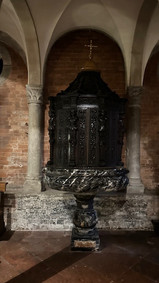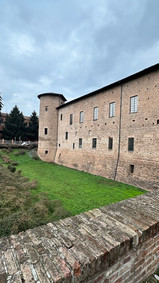Piacenza Italy - Italia
- Maria Scuor
- Jan 25, 2024
- 12 min read
Italiano in ogni sezione
We took a daytrip to Piacenza and were pleasantly surprised how much we saw in the day and how big it is. Located and the Province of the region of Emilia-Romanga, it is the ninth largest city in the region with about 102,000 inhabitants.
In 218 BC, Piacenza was founded as a Roman Military colony and settled with 6,000 Roman citizens. However, the Gauls (ancient Celtic people) didn’t like this and there were many wars until 200 BC when the Gauls sacked and burned the city, selling the inhabitants into slavery. The Romans were able to regain the region and recover about 2,000 citizens.
Like many Roman cities in Italy, Piacenza went through many wars and had struggles for control. But by the 1600’s it got to about 30,000 in population until famine and the plague killed up to 13,000 people. Austrian troops occupied the territory until 1860 when a plebiscite marked the entrance into the Kingdom of Sardinia and it was 1861 when 37,089 voters out of 37,585 voted for annexation. Piacenza was declared “Primogenita dell’Unità di Italia (First-born of the Unification of Italy). This was the consolidation of many states to form the unification of Italy. World War II Allies destroyed much of the railway and bridges because of Piacenza’s strategic position.
Even after the destruction of World War II, Piacenza has many historical places to visit and if you are in Northern Italy, it should be a place to stop for one night. You won’t be disappointed.
Abbiamo fatto una gita di un giorno a Piacenza e siamo rimasti piacevolmente sorpresi da quanto abbiamo visto durante il giorno e da quanto sia grande. Situata nella provincia della regione Emilia-Romanga, è la nona città più grande della regione con circa 102.000 abitanti.
Nel 218 a.C., Piacenza fu fondata come colonia militare romana e si stabilì con 6.000 cittadini romani. Tuttavia, ai Galli (antico popolo celtico) questo non piaceva e ci furono molte guerre fino al 200 a.C. quando i Galli saccheggiarono e bruciarono la città, vendendo gli abitanti come schiavi. I Romani riuscirono a riconquistare la regione e a recuperare circa 2.000 cittadini.
Come molte città romane in Italia, Piacenza ha attraversato molte guerre e ha avuto lotte per il controllo. Ma nel 1600 arrivò a circa 30.000 abitanti fino a quando la carestia e la peste uccisero fino a 13.000 persone. Le truppe austriache occuparono il territorio fino al 1860 quando un plebiscito segnò l'ingresso nel Regno di Sardegna e fu il 1861 quando 37.089 elettori su 37.585 votarono per l'annessione. Piacenza fu dichiarata "Primogenita dell'Unità d'Italia". Questo fu il consolidamento di molti stati per formare l'unità d'Italia. Gli alleati della seconda guerra mondiale distrussero gran parte della ferrovia e dei ponti a causa della posizione strategica di Piacenza.
Anche dopo la distruzione della Seconda Guerra Mondiale, Piacenza ha molti luoghi storici da visitare e se vi trovate nel Nord Italia, dovrebbe essere un posto dove fermarvi per una notte. Non rimarrete delusi.
Documented below are the places we saw and here is a TikTok video of our day exploring.
Documentati sotto sono i luoghi che abbiamo visto ed ecco un video TikTok della nostra giornata esplorativa.
Piacenza Cathedral
The Piacenza Cathedral or Duomo di Piacenza is a Romanesque Roman Catholic Cathedral dedicated to the Assumption of the Virgin Mary and Saint Justine. There are few remains that trace this site back to a paleochristian basilica as Piacenza was razed to the ground during the Gothic war by Totila in 546.
Documents describe Bishop Sigifredo of Piacenza as the founder of Saint Justine as in August 1001, the relics of the saint were transferred to Piacenza and Bishop Sigifredo received them and placed them in the final resting place in the Cathedral in her name.
The current structure was built between 1122 and 1233 and has an external length of 85m and a façade height of 32m, which makes it the largest Romanesque church in Emilia-Romagna. The façade is made of pink marble and gilded stone and has three portals decorated with statues. The inside has a central nave and two aisles divided by 25 pillars. The crypt, on the Greek cross plan, has 108 Romanesque small columns and is home to the relics of Saint Justina of Padove.
Il Duomo di Piacenza è una cattedrale romanica cattolica dedicata all'Assunzione della Vergine Maria e a Santa Giustina. Pochi sono i resti che fanno risalire questo sito ad una basilica paleocristiana, in quanto Piacenza fu rasa al suolo durante la guerra gotica da Totila nel 546.
I documenti descrivono il vescovo Sigifredo di Piacenza come fondatore di Santa Giustina, poiché nell'agosto del 1001 le reliquie della santa furono trasferite a Piacenza e il vescovo Sigifredo le ricevette e le depose nell'ultima dimora della Cattedrale a suo nome.
L'attuale struttura fu costruita tra il 1122 e il 1233 e ha una lunghezza esterna di 85 m e un'altezza della facciata di 32 m, che la rende la più grande chiesa romanica dell'Emilia-Romagna. La facciata è realizzata in marmo rosa e pietra dorata e presenta tre portali decorati con statue. L'interno è a navata centrale e a due navate divise da 25 pilastri. La cripta, a croce greca, presenta 108 colonnine romaniche e custodisce le reliquie di Santa Giustina di Padove.
Here are some photos of the Duomo - Ecco alcune foto del Duomo
Basilicas - Basiliche
We saw two basilicas in Piacenze from the outside as they were closed. The first we saw was the Basilica of San Francesco d’Assisi which was built in Gothic style between 1268 and 1363. Part of a monastic complex built by the Friars after Ubertino Landi donated the lands to the order, became a symbol of pacification between two factions, Ghibelline faction that Ubertino was one of the main exponents and Guelph faction, dominated by the Scotti family.
The façade is of terracotta and over the centuries, it was decorated with various works of art and the convent expanded to include three cloisters. In 1797 the order of Friars was suppressed and the church was converted into a hospital and warehouse. That didn’t last long as it was re-consecrated as a church in 1806.
The building has similarities with the Basilica of San Francesco in Bologna. It has a marble staircase with 8 steps and has three portals on the façade. The main portal is made of 14th century marble and the two side portals, made at a later date are made of stone. The interior has basilica structure with three naves and on the sides of the building there are some chapels. The one of the Immaculate Conception dates back to 16th century and is decorated by frescoes by Giovanni Battista Trotti and the chapel to San Francesco is from the 17th century.
Abbiamo visto due basiliche a Piacenze dall'esterno in quanto erano chiuse. La prima che abbiamo visto è stata la Basilica di San Francesco d'Assisi che fu costruita in stile gotico tra il 1268 e il 1363. Parte di un complesso monastico costruito dai frati dopo che Ubertino Landi donò le terre all'ordine, divenne simbolo di pacificazione tra due fazioni, quella ghibellina di cui Ubertino fu uno dei principali esponenti e quella guelfa, dominata dalla famiglia Scotti.
La facciata è in cotto e nel corso dei secoli è stata decorata con varie opere d'arte e il convento si è ampliato fino a comprendere tre chiostri. Nel 1797 l'ordine dei Frati fu soppresso e la chiesa fu trasformata in ospedale e magazzino. Non durò a lungo perché fu riconsacrata come chiesa nel 1806.
L'edificio presenta somiglianze con la Basilica di San Francesco a Bologna. Ha una scala in marmo con 8 gradini e presenta tre portali sulla facciata. Il portale principale è in marmo del XIV secolo e i due portali laterali, realizzati in epoca successiva, sono in pietra. L'interno ha una struttura basilicale a tre navate e ai lati dell'edificio si trovano alcune cappelle. Quella dell'Immacolata Concezione risale al XVI secolo ed è decorata da affreschi di Giovanni Battista Trotti e la cappella di San Francesco è del XVII secolo.
Here are some photos of Basilica of San Francesco which the interior photos I took off of the internet. Ecco alcune foto della Basilica di San Francesco che le foto degli interni ho preso da internet.
Basilica di Sant'Antonino
The second we saw was the Basilica of Sant’Antonino, who is the patron saint of Piacenza. The first building dedicated to the saint was commissioned by San Vittore, the first bishop of Piacenza and built between 350 and 375. During the 10th century it was heavily damaged by the Hungarian invasions and following this bishop Sigifredo of Piacenza decided for a reconstruction which included the large octagonal bell tower with three orders of mullioned windows and three new naves.
The Basilica is of Romanesque architecture and is located in the historic center of Piacenza. It has two entrances: the first located on the western side and built in the 11th century and the second called “Portal of Paradise” is located on the northern façade and was built around the 14th century. It has sculptures of Adam and Eve on the marble portal.
Inside, at the central nave where the alter stands, is an urn located below the main alter of the relics of Saints Antoninus and Victor. The central nave has a beautifully frescoed vault of Gothic architecture. The right and left naves house alters or chapels dating back to the 15th and 16th century.
La seconda che abbiamo visto è stata la Basilica di Sant'Antonino, che è il santo patrono di Piacenza. Il primo edificio dedicato al santo fu commissionato da San Vittore, primo vescovo di Piacenza e costruito tra il 350 e il 375. Nel corso del X secolo fu pesantemente danneggiata dalle invasioni ungarie e in seguito a ciò il vescovo Sigifredo da Piacenza decise per una ricostruzione che comprendeva il grande campanile ottagonale con tre ordini di bifore e tre navate nuove.
La Basilica è di architettura romanica e si trova nel centro storico di Piacenza. Ha due ingressi: il primo situato sul lato occidentale e costruito nell'XI secolo e il secondo chiamato "Portale del Paradiso" si trova sulla facciata settentrionale e fu costruito intorno al XIV secolo. Ha sculture di Adamo ed Eva sul portale di marmo.
All'interno, nella navata centrale dove si trova l'altare, si trova un'urna posta sotto l'altare maggiore delle reliquie dei Santi Antonino e Vittore. La navata centrale ha una volta splendidamente affrescata di architettura gotica. Le navate destra e sinistra ospitano altari o cappelle risalenti al XV e XVI secolo.
Here are some photos of Basilica Antonino – Ecco foto della Basilica Antonino
I used the following links for photos inside the Basilica - Ho usato i seguenti link per le foto all'interno della Basilica
Di Mongolo1984 - Opera propria, CC BY-SA 4.0, https://commons.wikimedia.org/w/index.php?curid=82458558
Horse Square – Piazza Cavalli
With the very large market and Christmas decorations it was very difficult to take good pictures of this Piazza Cavalli. The square is located in the heart of the city and was once called Piazza Grande, but the name was changed after the placement of two bronze equestrian statues.
These statues were commissioned by Ranuccio I Farnese, Duke of Parma and Piacenza and were sculpted by Tuscan sculptor Francesco Mochi and took 16 years to complete. Ranuccio wanted to pay homage to the memory of his father Alessandro Farnese and ensure the permanence of his memory in the future. Mochi cast the first statue in the summer of 1612 and the second between 1620 and 1625. The statues rest on a high marble base and have cherubs and coats of arms and curved plaques with text.
Ranuccio is depicted as a daring Roman warrior in armor and kilt and holding a diploma. His horse is sculpted as graceful and agile and perfectly tamed by his rider. Where Alessandro is wrapped in a dynamic cloak and in a position that is anything but classic and static. His horse looks more frantic with his messy mane and different appearance, something Mochi wanted views to easily compare.
Con il mercato molto grande e le decorazioni natalizie è stato molto difficile scattare belle foto di questa Piazza Cavalli. La piazza si trova nel cuore della città e un tempo si chiamava Piazza Grande, ma il nome è stato cambiato dopo la collocazione di due statue equestri in bronzo.
Queste statue furono commissionate da Ranuccio I Farnese, duca di Parma e Piacenza e furono scolpite dallo scultore toscano Francesco Mochi e richiesero 16 anni per essere completate. Ranuccio ha voluto rendere omaggio alla memoria del padre Alessandro Farnese e assicurare in futuro la permanenza della propria memoria. Mochi fuse la prima statua nell'estate del 1612 e la seconda tra il 1620 e il 1625. Le statue poggiano su un'alta base marmorea e hanno putti e stemmi e placche curve con testo.
Ranuccio è raffigurato come un audace guerriero romano in armatura e kilt e in possesso di un diploma. Il suo cavallo è scolpito come aggraziato e agile e perfettamente addomesticato dal suo cavaliere. Dove Alessandro è avvolto in un mantello dinamico e in una posizione tutt'altro che classica e statica. Il suo cavallo sembra più frenetico con la sua criniera disordinata e l'aspetto diverso, qualcosa che Mochi voleva vedere per confrontarsi facilmente.
Here are some photos of the square and statues - Ecco alcune foto della piazza e delle statue
Farnese Palace – Palazzo Farnese
This palace started as a fortress in the hands of the Visconti family in 1373 who dominated over Piacenza. Originally, the Visconti citadel was a fort with four towers on each corner and defended by a moat. On the front there was a keep and it was equipped with a drawbridge. In 1447 the citadel was the last to surrender to Duke of Milan Francesco Sforza, after resistance led by Piacenza leader Alberto Scotti.
Between 1525 and 1545, after being stripped of all military artillery, the citadel was used as the seat for the papal administration. Pope Paul III, a member of the Farnese family, carried out the detachment of Piacenza and Parma from the Duchy of Milan and erecting a Duchy of Parma and Piacenza under his son Pierluigi Farnese (yes, some Pope’s had children back then).
The duke chose Piacenza as the capital of the Duchy and lived at the Viscount citadel while he constructed a more modern castle on the south-west side of the city, which was a more strategic position to control attacks. Because of this, Emperor Charles V thought it was a conspiracy and therefore attacked the duke inside the old citadel, slitting his throat and throwing him outside a window.
Despite the conspiracy theory, Pierluigi’s son, Ottavio Farnese, managed to keep the title of duke and also became closer to the emperor. Control of Piacenza was his again and he married the Margaret, the daughter of the emperor. Ottavio moved the capital to the city of Parma and moved there, while Duchess Margherita made the decision to stay in Piacenza.
The vision of keeping the foundation of the Visconte Citadel didn’t work out therefore a new architect Jacopo Barozzi, known as the Vignola and the plans were drawn up in 1561. Works stopped when the Duchess abandoned Piacenza and restarted in 1589 with contributions from the Piacenza community under the Vignola’s son, Giacinto. Work again stopped and many elements of the project didn’t get realized.
When no male lineage to the Farnese family remained, the duchy was passed to Charles of Bourbon. However, during the Napoleonic occupation, the palace was occupied by French soldiers and after the death of Duke Ferdinand in 1803, the palace was stripped of all marble, decorations and valuable items that were sent to France. In 1813 it became a prison and during the second world war it became a refuge for those displaced.
Between 1972 and 1976 after obtaining state funding, the first restorations of the building were started. In 1976 the building was granted to Piacenza to be used a as civic museum and in 1977, the provincial headquarters of the State Archives was opened. In the 80’s renovation of the gates, staircases and the bottom of the courtyard was restored and in 1988 the first sections of the civic museums were open to the public and in 2014 the building became the property of the municipality through cultural state federalism.
The palace is now open to the public and offers many collections to see and they offer various learning opportunities for children to learn about the collections and history. You can find more information by visiting the Museum of Palazzo Farnese
Questo palazzo nacque come fortezza nelle mani della famiglia Visconti nel 1373 che dominava Piacenza. In origine, la cittadella viscontea era una fortezza con quattro torri ad ogni angolo e difesa da un fossato. Sulla parte anteriore c'era un mastio ed era dotato di un ponte levatoio. Nel 1447 la cittadella fu l'ultima ad arrendersi al duca di Milano Francesco Sforza, dopo la resistenza guidata dal condottiero piacentino Alberto Scotti.
Tra il 1525 e il 1545, dopo essere stata spogliata di tutta l'artiglieria militare, la cittadella fu utilizzata come sede dell'amministrazione pontificia. Papa Paolo III, membro della famiglia Farnese, portò a termine il distacco di Piacenza e Parma dal Ducato di Milano e l'erezione di un Ducato di Parma e Piacenza sotto il figlio Pierluigi Farnese (sì, alcuni Papi avevano figli allora).
Il duca scelse Piacenza come capitale del ducato e visse nella cittadella viscontesa mentre costruiva un castello più moderno sul lato sud-ovest della città, che era una posizione più strategica per controllare gli attacchi. Per questo motivo, l'imperatore Carlo V pensò che si trattasse di una cospirazione e quindi attaccò il duca all'interno della vecchia cittadella, tagliandogli la gola e gettandolo fuori da una finestra.
Nonostante la teoria del complotto, il figlio di Pierluigi, Ottavio Farnese, riuscì a mantenere il titolo di duca e si avvicinò anche all'imperatore. Il controllo di Piacenza fu di nuovo suo e sposò Margherita, figlia dell'imperatore. Ottavio trasferì la capitale nella città di Parma e si trasferì, mentre la duchessa Margherita prese la decisione di rimanere a Piacenza.
L'idea di mantenere le fondamenta della Cittadella Viscontea non andò a buon fine e si concretizzò un nuovo architetto Jacopo Barozzi, detto il Vignola, i cui progetti furono redatti nel 1561. I lavori si interruppero quando la duchessa abbandona Piacenza e ripresero nel 1589 con i contributi della comunità piacentina sotto il figlio del Vignola, Giacinto. I lavori si sono nuovamente fermati e molti elementi del progetto non sono stati realizzati.
Quando non rimase alcuna discendenza maschile dalla famiglia Farnese, il ducato passò a Carlo di Borbone. Tuttavia, durante l'occupazione napoleonica, il palazzo fu occupato dai soldati francesi e dopo la morte del duca Ferdinando nel 1803, il palazzo fu spogliato di tutti i marmi, le decorazioni e gli oggetti di valore che furono inviati in Francia. Nel 1813 divenne carcere e durante la seconda guerra mondiale divenne rifugio per gli sfollati.
Tra il 1972 e il 1976, dopo aver ottenuto finanziamenti statali, furono avviati i primi restauri dell'edificio. Nel 1976 l'edificio fu concesso a Piacenza per essere adibito a museo civico e nel 1977 fu aperta la sede provinciale dell'Archivio di Stato. Negli anni '80 è stato restaurato il cancello, le scale e il fondo del cortile e nel 1988 sono state aperte al pubblico le prime sezioni dei musei civici e nel 2014 l'edificio è diventato proprietà del comune attraverso il federalismo culturale statale.
Il palazzo è ora aperto al pubblico e offre molte collezioni da vedere e offrono varie opportunità di apprendimento per i bambini per conoscere le collezioni e la storia. Puoi trovare maggiori informazioni visitando il Museo di Palazzo Farnese
Here are some photos of the Palazzo Farnese - Ecco alcune foto del Palazzo Farnese

There was so much to see in Piacenza and here are photos of some of the sights - C'era così tanto da vedere a Piacenza ed ecco le foto di alcuni dei luoghi d'interesse
































































































































Comments